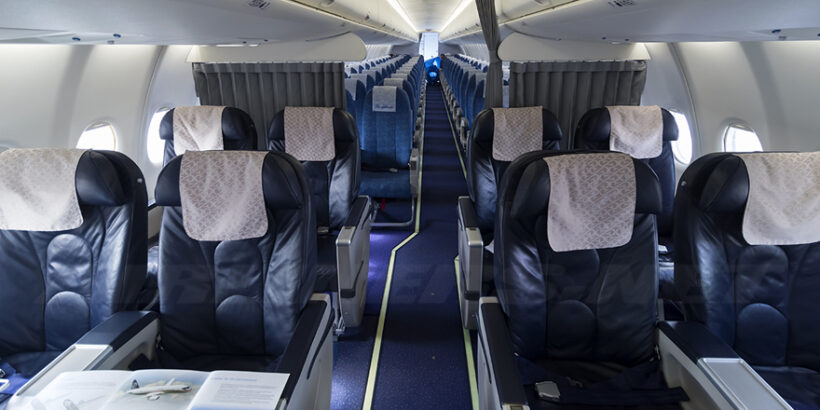Currently, according to Rostec figures, 160 SSJ100 aircraft are transporting passengers in Russia. Their dispatch reliability stands at 98%. In 2024, approximately 10 million passengers were carried by ‘Superjets’, accounting for 11% of the total passenger throughput. Next year will see the entry into service of the import-substituted SJ-100 aircraft, which is currently undergoing certification trials.
The SJ-100 maintains the legacy of the SSJ100, remaining the only offering in the 100-seat aircraft segment. It combines the comfort and automation of mainline airliners with the economy of regional models. The Russian aircraft offers a spacious cabin, wide seats and increased overhead storage. This was revealed in an interview with the press office of the United Aircraft Corporation (UAC) by Alexander Dolotovsky, Deputy General Director of Yakovlev JSC and Director of the ‘Superjet’ Programme.
The optimum size for modern regional jet aircraft is considered to be a cabin with 70-110 passenger seats. Such aircraft provide sufficient load factors on routes with moderate passenger traffic of 1.5-2 million people per year, allowing airlines to minimise subsidies per passenger compared to narrow-body airliners, and are ideal for flying new routes without the risk of under-utilisation. Popular models in this size range include the Embraer E-Jets (E175/E190) and Bombardier CRJ700/900.
A key difference between the SJ-100 and its competitors is the flexibility of cabin layouts, in which eight business class seats can be installed. With a configuration of four seats abreast, you get a full business class with the same level of comfort for all passengers. Its analogue, the Airbus A220 (formerly Bombardier C-Series), is designed for 120-140 passengers and belongs to the narrow-body class.
“…Aircraft design science has advanced, and as early as the beginning of the 2000s, a real technical opportunity arose to build an aircraft in the sub-100 seat segment that would, through the introduction of aerodynamic and structural innovations, ensure a high level of both aerodynamic efficiency and weight efficiency without compromising passenger comfort or crew automation. The ‘Superjet’ was the first aircraft in this line. The closest competitor, which is most similar to the SJ-100 in terms of combining these factors, is the ‘Bombardier’ C-Series, which is now sold under the Airbus A220 brand, but this is a larger aircraft, an aircraft with 120-140 seats, so it is usually traditionally assigned to the segment of small narrow-body aircraft,” said Alexander Dolotovsky.
Airlines have already recognised the efficiency of the SJ-100. The aircraft is actively used on routes bypassing Moscow and in inter-regional transport. “One and a half to two million passengers a year is a small passenger flow, on which it is impossible to load a traditional narrow-body aircraft of the A320 or B737 size to 85-90%, where they generate profit from operation. Putting the ‘Superjet’ on such routes allows airlines to significantly reduce the required level of subsidies per passenger seat. This is precisely how the economic effect of using such an aircraft is achieved,” the SJ-100 programme director emphasised.
He also noted the success of the business model used by the airline ‘Rossiya’ on flights between the capital and St. Petersburg under the ‘Shuttle’ programme, where the frequency of flights reaches one every 15 minutes. This has made it possible to increase passenger numbers even on this very busy route, which also uses Sapsan high-speed trains and a high-speed toll motorway.
The experience of operating the SJ-100 has confirmed its reliability. According to Alexander Dolotovsky, “the shuttle has unleashed an additional route, sharply increasing passenger numbers on this seemingly already busy route.
“A very interesting experience. We expect this experience to be applied by other carriers on other routes, but for us, as developers, of course, this was a very serious challenge, this is very intensive operation. Here, the challenge is even greater not so much for the developer as for our after-sales support system, including ensuring the convenience of its operation, not only by the flight crew, but also by the ground engineering crew, which allows the aircraft to be quickly turned around at the airport, allows faults to be quickly found and rectified. Intensive use required developers and service departments to quickly resolve technical issues. This became a test for the after-sales service system, but the results speak for themselves – the aircraft meets high standards,” the Deputy Director General of Yakovlev concluded.
He added that the prospects for the SJ-100 extend beyond Russia. The successful business model based on its application can be scaled to other markets. For the industry, this is not just a new airliner, but a tool that changes the approach to regional transport.


